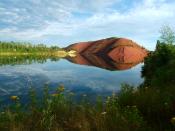IRON
Iron in its pure state is soft, malleable and ductile (that can be stretched, drawn or hammered thin without breaking ((Webster's Dictionary, 419, 1988)) with a hardness of 4-5. It is easily magnetized at room temperatures and this property disappears when heated above 790 degrees Celsius.. Metal iron occurs in a free state in only a few localities, notably Greenland (Encarta, 1996). One of the physical properties of iron as an ore is its color which can be black, brown or even reddish. Hematite is the most important iron ore, commonly occurs as 'kidney ore' - so -called because of its shape (Symes, 1988, 56). Other ores included goethite, magnetite, siderite, and bog iron (Encarta, 1996). Even though iron is tough and hard it is still easy to work. Iron is a active metal and will combine with halogens, carbon, etc. It has an atomic weight 55.847,
it's atomic number is 26, it's specific gravity is 7.86, it's melting point is 1535 degrees Celsius, and it's boiling point is 3000 degrees Celsius. It burns in oxygen forming ferrous oxide. When exposed to moist air, iron becomes corroded, forming a reddish - brown, flaky, hydrated ferric oxide, commonly known as rust. (Encarta, 1996)
Iron is formed in shallow seas. It comes out of the water and collects on the sea floor. This creates an underwater deposit. This process occurs over billions of years. Through plate movement the whole sea floor is eventually moved up out of the water. Once out of the water, the iron has formed a land deposit. The biggest iron deposit in the United States is in the Great Lakes. Northern Minnesota is often called the Iron Range. There are two ways iron deposits are located. In the...


